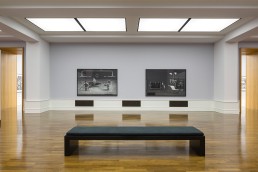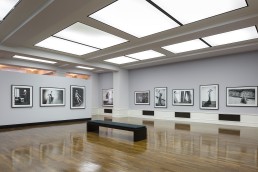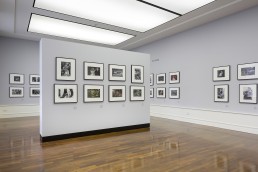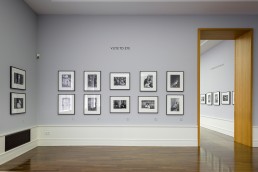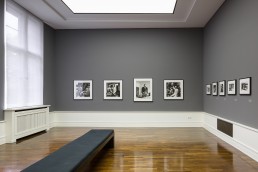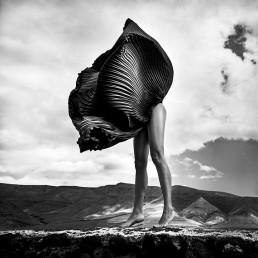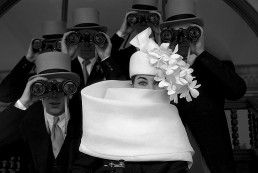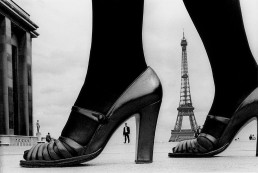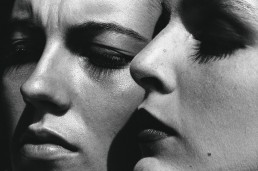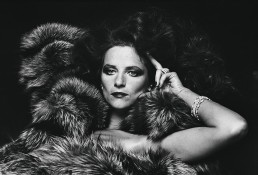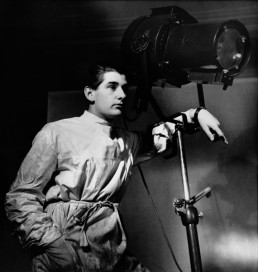The foundation has presented Helmut Newton’s works alongside that of other notable colleagues in the past; with this newest show including Frank Horvat and Szymon Brodziak, two photographers are invited who have made a name for themselves in fashion and portraiture.
Frank Horvat is without doubt among the most important photographers of the 20th century. People have always remained at the center of his interest. He always strived to go beyond traditionally staged fashion shots, adding surprising contrasts or combining female models with everyday people in a public setting. With such photographs he strongly shaped the spirit of the times.
In his first institutional exhibition in Germany, Szymon Brodziak presents large-format black & white photographs. The stages he creates for his photographic orchestrations are both real and unexpected, featuring a predominantly female cast.
The two monographic presentations will be complemented by the second part of Helmut Newton’s permanent loan collection, which has been housed since the establishment of his foundation at the Museum for Photography. This show will likewise feature original vintage prints of Newton’s iconic fashion photographs, nudes, portraits, and self-portraits, many of which have not previously been shown at this location.
Selected Works
Permanent Loan Selection II
Matthias Harder
The Helmut Newton Foundation has previously presented the works of notable photographers alongside that of Helmut Newton, each time as a three-way exhibition. The extended approach was an explicit wish by the German-Australian photographer upon establishing his foundation. Earlier exhibitions with David LaChapelle and James Nachtwey (2006), and with Ralph Gibson and Larry Clark (2007), examined positions between socially relevant documentation and artistic orchestration. Now, with Frank Horvat and Szymon Brodziak, two photographers have been invited who have made a particular name for themselves in fashion and portraiture. As with Newton, nudes and genre-crossing works also figure in the work of these artists, each working in a quite distinct style. All this can be discovered in the exhibition Newton. Horvat. Brodziak, which presents more than 300 photographs in various formats and from different time periods.
Frank Horvat is without doubt among the most important photographers of the 20th century. Horvat himself has explained how, at the age of 16, he aspired to be a writer. But the photojournalism of Henri Cartier-Bresson in Paris during the 1950s, along with the rise in “human interest” photography, so fascinated the young Horvat that he ended his writing career even before it began. Instead he took up the camera, and his first reportages were published in the Italian magazine Epoca. He went on to observe people in the most diverse situations with great empathy, often exercising a respectful modicum of restraint. A storybook career began, including his participation in the legendary exhibition The Family of Man and the publication of many of his photographs in magazines such as Paris Match, Picture Post, and Life. In 1959 he started a brief, three-year membership in the photographic cooperative Magnum. The 1950s and 1960s were the heyday of the “picture story”, and Horvat was among the photographers reporting from all over the world. His local editors received his images from places like India, Brazil, Hong Kong, and Egypt.
People were always at the center of his interest, be it reportage, portraiture, or re-enactments of old masters including nudes. By the end of the 1950s he was increasingly turning to fashion photography, which he published in Elle, Vogue, and later, Harper’s Bazaar. Like his contemporaries Richard Avedon, William Klein, and Helmut Newton, Horvat always strived to go beyond traditionally staged fashion shots, by adding surprising contrasts or combining female models with the public in everyday settings. His photographs both reflected and strongly influenced the spirit of the times. In recent years, things have quieted down somewhat around Frank Horvat, who has exchanged the world of fashion and advertising for more personal subjects from his life in Cotignac, in southern France. This exhibition will present for the first time in Berlin 200 of his multifaceted photographs from his recent book and exhibition project House with Fifteen Keys, which Horvat sees as his personal testimony and legacy.
The Polish photographer Szymon Brodziak is a comparably intense storyteller with the camera, even though he is two generations removed from Horvat and Newton. In his first institutional exhibition in Germany, 30 large-format black & white photographs from his recent monograph One will be presented in the main room of the museum. The settings that Brodziak uses for his photographic orchestrations are both real and unexpected, featuring a predominantly female cast. The roles that the models play on these stages are just as unusual. Costa Rican beauty queen Leonora Jiménez, for example, conquers a scrapyard like the Terminator. Dressed in an evening gown, she triumphantly brandishes a flag while standing atop a heap of compressed car wrecks. We see her cascading blonde hair and stiletto heels as she dangles in the clutches of a massive grabbing crane, otherwise accustomed to lifting old cars from one place to another in the scrapyard.
The nudity of the young women he portrays varies between natural grace and provocative stylization, for a client like Playboy, for example. In The Hunting, we are confronted with two naked women: one, with small deer antlers in her hair, is being stalked, while the other plays the hunter, outfitted with a shotgun and knife. The “deer” played by the first model – is slain, according to the narrative, and the trophy ends up in a wooden rotunda on the wall. The hunt represents power and submission. Exaggeration is used as a stylistic device. Brodziak’s pictures exude a blend of subtle eroticism and feminine elegance, be it for furniture, cars, or coffee. As a kind of mood photography, they evoke a certain atmosphere for the viewer, whereby the actual subject of the photo is sometimes radically marginalized. Brodziak is not only a master of technique and setting, he also has the corresponding sensitivity needed to create quiet, intimate character sketches. Brodziak indulges in the clichés and beauty ideals of fashion and nude photography, while simultaneously calling them into question.
The two monographic presentations will be complemented by the second part of Helmut Newton’s permanent loan collection, which has been housed since the foundation’s establishment at the Museum for Photography. This is the continuation of the first presentation of the permanent loan collection, which filled the foundation’s entire exhibition space from December 2014 until May 2015. This show will likewise feature more than 70 original vintage prints of Newton’s iconic images, many of which have not previously been shown here, such as portraits of Jeanne Moreau, Charlotte Rampling, and Karl Lagerfeld.
Newton’s conceptual approach to portraiture finds expression in a color series from the 1980s, in which he visits celebrities such as David Hockney, David Bowie, and Niki de Saint Phalle in their bedrooms. The pictures are presented next to one another in pairs: one photo depicts the subject sitting on the edge of the bed; the second shows them opening a nightstand drawer. Newton directs his gaze at two rather intimate areas: the bedroom (as a whole) and its inner secrets – from pills to tissues or diaries, which can be seen in the open drawer. Never before have prominent personalities been portrayed in such a way.
We are met by intimate poses in other portraits as well, captured with Newton’s unrivalled combination of voyeurism and exhibitionism. In his nude and fashion photographs we also discover sophisticated, erotically charged scenarios. In June’s Room, the visitor can discover a selection of his small-format self-portraits, along with portraits Newton made of his wife June during the last decades. As a visualized narrative of their life and love, these select images, which are just a small part of the series Us and Them, allow us an uninhibited, intimate view of the daily life shared by this exceptional photography couple.
